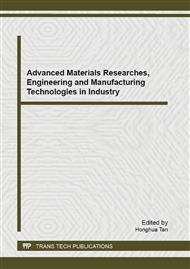[1]
Oscar L,Francisco D,Alejandro G,Pablo F C. Eliminating Ground Current in a Transformerless Photovoltaic Application, IEEE Trans. on energy conversion, 2010, vol. 25, no. 1, pp.140-147.
Google Scholar
[2]
Eugenio G,Pablo S,Alfredo U,Jesus L,Luis M. Ground Currents in Single-phase Transformerless Photovoltaic Systems, Progress in photovoltagics: research and applications, 2007, pp.629-650.
Google Scholar
[3]
Kerekes T, Teodorescu R, Rodriguez P, Vazquez G, Aldabas E. A New High-Efficiency Single- Phase Transformerless PV Inverter Topology, IEEE Trans. on industrial electronics, 2011, vol. 58, no. 1, pp.184-191.
DOI: 10.1109/tie.2009.2024092
Google Scholar
[4]
Salas V, Alonso-Abella M, Olias E, Chenlo F, Barrado A. DC current injection into the network from PV inverters of <5 kW for low-voltage small grid-connected PV systems, Solar Energy Materials & Solar Cells 91, 2007, pp.801-806.
DOI: 10.1016/j.solmat.2006.12.016
Google Scholar
[5]
Salas V, Olias E, Alonso M, Chenlo F. Overview of the legislation of DC injection in the network for low voltage small grid-connected PV systems in Spain and other countries, Renewable and Sustainable Energy Reviews, 2008, 12, pp.575-583.
DOI: 10.1016/j.rser.2006.07.009
Google Scholar
[6]
Farag B, David A, Matthew A. Minimisation of DC current component in transformerless Grid-connected PV inverter application, International Conference on Environment and Electrical Engineering (EEEIC), Rome, 2011, pp.1-4.
DOI: 10.1109/eeeic.2011.5874754
Google Scholar
[7]
Lim Nge Chee, O-M. Midtgard, L. Norum, T.O. Saetre, Power Loss Analysis for Single Phase Grid-Connected PV Inverters, Telecom- munications Energy Conference, 2009. INTELEC 2009. 31st International, 2009, vol., no, pp.1-5.
DOI: 10.1109/intlec.2009.5352038
Google Scholar
[8]
Qun-jing Wang, Quan Chen, Wei-dong Jiang, Cun-gang Hu, Analysis of Conduction Losses in Neutral-Point-Clamped Three-Level Inverter, Transactions of China Electrotechnical Society, 2007, vol. 22, no. 3, pp.66-71.
DOI: 10.1109/icems12746.2007.4412158
Google Scholar
[9]
Quan Chen, Qun-jing Wang, Wei-dong Jiang, Cun-gang Hu, Analysis of Switching Losses in Diode-Clamped Three-Level Converter, Transactions of China Electrotechnical Society, 2008, vol. 23, no. 2, pp.68-75.
Google Scholar
[10]
Feng Hong, Ren-zhong Shan, Hui-zhen Wang, Yang-guang Yan, Analysis and Calculation of Inverter Power Loss, Proceedings of the CSEE, vol. 28, no. 15, pp.72-78, 25 May. (2008).
Google Scholar
[11]
H. Schmidt, C. Siedle, J. Ketterer, Inverter for transforming a DC voltage into an AC current or an AC voltage, Germany, 2003, EP 1369985 A2.
Google Scholar
[12]
Hyosung Kim, Kyoung-Hwan Kim, Fliter design for grid connected PV inverters, IEEE International Conference on Sustainable Energy Technologies, ICSET 2008, vol., no., pp.1070-1075.
DOI: 10.1109/icset.2008.4747165
Google Scholar
[13]
S. Clemente, Application characterization of IGBTs, International Rectifier Application Note, AN-990.
Google Scholar


